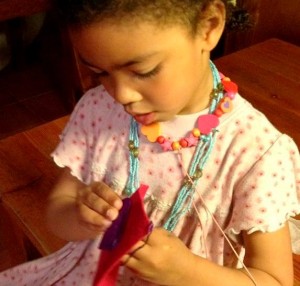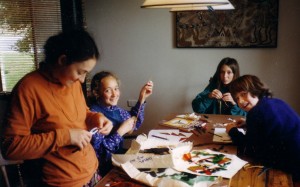Love gifts
 “Love gifts” are gifts made as a result of our own efforts and thoughtfulness – they become symbols of the love we have for each other. Such gifts do not have to be expensive or even “material” to be treasured. We can make a gift of our own artistic work; of music, or poetry, stories and dramatic performances. We can even make gifts of our time in promissory notes, to give a massage, bring a cup of tea, make a meal, help in the garden etc., to be taken up at a later time. We can of course also make the gift of time and skill in little gifts of craft or hand-prepared food and so on.
“Love gifts” are gifts made as a result of our own efforts and thoughtfulness – they become symbols of the love we have for each other. Such gifts do not have to be expensive or even “material” to be treasured. We can make a gift of our own artistic work; of music, or poetry, stories and dramatic performances. We can even make gifts of our time in promissory notes, to give a massage, bring a cup of tea, make a meal, help in the garden etc., to be taken up at a later time. We can of course also make the gift of time and skill in little gifts of craft or hand-prepared food and so on.
However, you need to be aware that other people may not value these “love gifts” as much as you would like your family to value them. Sometimes it is helpful to prepare your children for this: “In our family we like to make presents which we can put our love into. Other people may choose to give presents in other ways and that is okay too. Each person has to find the way which is right for them.”
The important thing is to let our children know by our example that a love gift of our own making is a valued, very special present for someone we love.
View/download pdf Gifts
Some suggestions for love gifts
Stories. One of the greatest gifts we can give children, as parents and grandparents, is a sense of history— we can do this by sharing our personal history. Our children have no comprehension of what life was like without cars and electricity and washing machines. Anyone can share a little incident they remember, adding richness to it by descriptions of the house, furniture, animals, lifestyles and traditions. Children love to hear about the childhood of their elders, their magic moments and adventures, about Christmas and birthdays, special happy times. They also love to hear about themselves as little babies, what they did and said.
A good way to build such a story is to form it clearly in your mind with a clear story beginning … “Once upon a time there was a little boy called Herbert who had fair skin, black, black hair and green eyes …” and a setting of the scene …“he lived in a two storey house with …” It helps to describe a special incident …“One day …” and bring it to a conclusion …“ and so he went to bed, very tired, but very happy.”
The story can be simply “told” or it can be written out to enjoy time and time again.
Not just young children can enjoy such stories, 9 and 10 year olds often want to know about themselves in the past and 11 and 12 year olds are beginning to experience what history is, and have more appreciation of it. From 14 onwards, there is an increasing interest in their own “biography” and there can be a deeper appreciation of the biographical stories of well-loved adults as well.
Of course the children themselves can make gifts of their own stories for the adults who love them.
Poems. Simple poems for the enjoyment of language, and about our families, our activities and adventures together also make special presents. They do not have to rhyme to be in poetry form, though delight in the words is always preferable. It can help make them more special to present them beautifully on good paper or in a card or in a little homemade book. Gold and silver pens on coloured paper can make them look special yet is simple to organise.
Songs. Poems can be put to music, existing or new, to make a song to be sung at a specific time. It feels particularly special singing a song created for just this event.
Music. Those who play instruments or sing can make gifts of a musical item, specially prepared for a special person.
Drama. Children (or the whole family) can create little plays to perform for parents or special guests. A song can even form a basis for a small children’s play.
Promissory notes. We can commit ourselves to a gift of our skills, our time, or to just spoil our loved ones for a little while. Again such “promises” can be made special by being written up on little cards (coloured “business cards” from cheap goods shops are very useful here). Ideas for this are unlimited: to give a massage, bring a cup of tea, make a meal, help in the garden, make something with Dad or Granddad, to cook a special cake with Grandma or Uncle, to have a day/afternoon which is “all ours, absolutely, with no interruptions”.
As children get older we can also ‘gift’ them the time to teach them one of our own skills, practical, artistic or professional. Think of all the things you have been meaning to do with that special person, promise faithfully to do one of them and then do it!
Other ideas for making things together
There are many books available on simple crafts, cooking and other things to do with children, but here are a few ideas. For gifts, it is helpful to keep the emphasis on quality and beauty if you can: i.e. consider keeping things small and manageable, using reasonable quality materials which can be really enjoyed in the making as well as the receiving.
Paintings & Drawings. Children’s art work, mounted nicely (on cardboard, foam core or in a frame) can make good presents for discriminating relatives. The fresh expressiveness of children’s work can be a joy to art lovers. This is enriched further when the drawing is done consciously for each person, and when the child is given a chance to tell the story of what their drawing illustrates.
Special Cards. Cards can be made with windows or doors which open, revealing a drawing or painting, or with a special border. Again gold pens and coloured paper add a touch of “class”.
Candles. Small inexpensive “votive” candles can be dipped in coloured wax from melted coloured candles and old bits of crayon melted in a tin. Or they can be decorated with little candle stands of dried flowers, beads, felt or gum nuts etc.(Small candles are available cheaply in bulk from church candle supply stores.)
Larger candles can be decorated with coloured modelling wax.
Plants. Children can grow plants in pots for presents using easily grown seeds (eg calendula, nasturtium) or cuttings of herbs or native plants (eg rosemary, grevillea) or root divisions (eg mint, daisy, or herbs), or re-pot punnet flowering plants, herbs or bulbs.
Flowers. Bunches of flowers or posies from a child’s own garden.
Food. Food gifts can be varied. Gingerbread men or houses, sweets, biscuits, jam and pickles. Children can decorate labels, make cards and baskets for presentation.
Crafts. Consider crafts made from herbs grown in the garden (e.g. lavender). See books of traditional crafts, paper making etc.
Remember, what we are working with here is our love for other people, our appreciation for our own creative process, and a love of beauty.
Some anecdotes on hand-made gifts
There is something in making gifts for others or receiving such a gift which is particularly heart-warming, especially when someone learns a new skill to do it and produces something unexpected. One family decided that, to avoid the “Christmas-present-finding-angst”, they would pick from a hat the name of one extended family member and make them a present. One man secretly taught himself how to knit and made his wife a hot water bottle cover. In another family, a young man secretly taught himself to cross stitch and made his partner a cushion with a picture of her favourite bird stitched for it. There is also something particularly endearing about such ‘cross traditional gender skill’ presents because they are so unexpected. One can teach children to broaden their ideas about gender roles by such gifts— another gift in itself. My own father used to decorate our birthday cakes, turning the excellent cake my mother made into a train or something else special to delight us. Such gifts show love and care when words may not be so easily said! I call them ‘Love gifts’.
View/download pdf Gifts

See also
Possible present list A list of toys and materials for children which encourage healthy play.
Creating a peaceful, meaningful Christmas